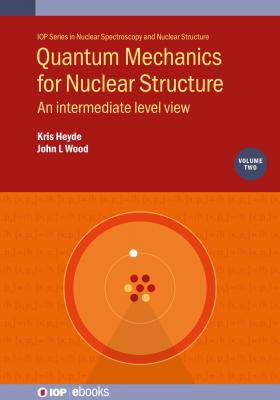Quantum Mechanics for Nuclear Structure, Volume 2. Professor Kris Heyde
Чтение книги онлайн.
Читать онлайн книгу Quantum Mechanics for Nuclear Structure, Volume 2 - Professor Kris Heyde страница 11

Dm0(l)(α,β,γ=0)=4π2l+1Ylm*(θ,ϕ)∣θ=β,ϕ=α;(1.229)
and for m = 0
D00(l)(α,β,γ)=d00(l)(β),(1.230)
and
∴d00(l)(β)=Pl(cosθ)∣θ=β.(1.231)
Theorem 1.11.1. The addition theorem for spherical harmonics,
Pl(cosθ)=∑m4π2l+1Ylm(θ2,ϕ2)Ylm*(θ1,ϕ1),(1.232)
where θ is defined by
cosθ≔cosθ1cosθ2+sinθ1sinθ2cos(ϕ1−ϕ2).(1.233)
Proof. Consider
〈l0∣D(ϕ,θ,0)∣l0〉=〈l0∣D(ϕ2,θ2,0)D(ϕ1,θ1,0)∣l0〉,(1.234)
where the group properties of rotations in ket space have been used. Then, from the completeness relation
〈l0∣D(ϕ,θ,0)∣l0〉=∑m〈l0∣D(ϕ2,θ2,0)∣lm〉〈lm∣D(ϕ1,θ1,0)∣l0〉,(1.235)
∴D00(l)(ϕ,θ,0)=∑mD0m(l)(ϕ2,θ2,0)Dm0(l)(ϕ1,θ1,0),(1.236)
and from equations (1.229) and (1.231),
Pl(cosθ)=∑m4π2l+1Ylm(θ2,ϕ2)Ylm*(θ1,ϕ1).(1.237)
□
1.12 Properties of the rotation matrices
The rotation matrices D(j)(α,β,γ) are unitary. Thus, their matrix elements Dmm′(j)(α,β,γ) obey:
Dm′m(j)(−γ,−β,−α)=Dmm′(j)*(α,β,γ),(1.238)
∑mDmm′(j)*(α,β,γ)Dmm″(j)(α,β,γ)=δm′m″,(1.239)
∑mDm′m(j)*(α,β,γ)Dm″m(j)(α,β,γ)=δm′m″.(1.240)
The reduced rotation matrices d(j)(β) are real. Thus, their matrix elements, dmm′(j)(β), from equation (1.238), obey:
dm′m(j)(−β)=dmm′(j)(β).(1.241)
From the general expression for the matrix elements of dmm′(j)(β), equation (1.167), it follows that
(−1)m′−md−m′,−m(j)(β)=dm′m(j)(β)=(−1)m′−mdmm′(j)(β),(1.242)
and hence
Dm′m(j)(α,β,γ)=(−1)m′−mD−m′,−m(j)*(α,β,γ).(1.243)
1.13 The rotation of 〈jm∣
The rotation of 〈jm∣ involves an important phase factor. From the rotation of ∣jm〉 by D(j)(α,β,γ):
D(α,β,γ)∣jm〉=∑m′Dm′m(j)(α,β,γ)∣jm′〉,(1.244)
∴〈jm∣D†(α,β,γ)=∑m′Dm′m(j)*(α,β,γ)〈jm′∣.(1.245)
Then, from the complex conjugate of equation (1.243):
〈jm∣D†(α,β,γ)=∑m′(−1)m′−mD−m′,−m(j)(α,β,γ)〈jm′∣,(1.246)
and replacing −m′↔m′, −m↔m, and noting that the sum is over m′=−j,−j+1,…,j−1,j and so is unaffected,
∴〈j,−m∣D†(α,β,γ)=∑m′(−1)−m′+mDm′m(j)(α,β,γ)〈j,−m′∣,(1.247)
∴(−1)−m〈j,−m∣D†(α,β,γ)=∑m′(−1)−m′Dm′m(j)(α,β,γ)〈j,−m′∣,(1.248)
i.e. (−1)−m〈j,−m∣ transforms like ∣jm〉. It is conventional to multiply both sides of equation (1.248) by (−1)j and then (−1)j−m〈j,−m∣ transforms like ∣jm〉, and the phase is real.
1.14 The rotation of the Ylm(θ,ϕ)
The transformations of the Ylm(θ,ϕ) under rotation follow from equation (1.221)
〈nˆ∣lm〉=Ylm(θ,ϕ)=Ylm(nˆ),(1.249)
and
D(R)∣nˆ〉=∣n′ˆ〉;(1.250)
whence from
D(R−1)∣lm〉=∑m′∣lm′〉〈lm′∣D(R−1)∣lm〉,(1.251)
i.e.
D(R−1)∣lm〉=∑m′∣lm′〉Dm′m(l)(R−1),(1.252)
then
〈nˆ∣D(R−1)∣lm〉=∑m′〈nˆ∣lm′〉Dm′m(l)(R−1).(1.253)
But
〈nˆ∣D(R−1)=〈nˆ′∣,(1.254)
∴Ylm(nˆ′)=∑m′Ylm′(nˆ)Dmm′(l)*(R),(1.255)
or
Ylm(θR,ϕR)=∑m′Ylm′(θ,ϕ)Dmm′(l)*(R).(1.256)
Similarly, from equation (1.248)
(−1)−mYl,−m(θR,ϕR)=∑m′(−1)−m′Yl,−m′(θ,ϕ)Dmm′(l)*(R).(1.257)
1.15 Exercises
1.1. Explore the commutator properties ofT1=00000−i0i0,T2=00i000−i00,T3=0−i0i00000,(1.258)in comparison with SO(3) and SU(2), (3,R) and (2,C).
1.2. Show thatd32(β)=c3−3c2s3cs2−s33c2sc3−2cs2s3−2c2s3cs23cs2−s3+2c2sc3−2cs2−3c2ss33cs23c2sc3,(1.259)where c≔cosβ2, s≔sinβ2.
1.3. Show that the results of equation (1.167) agree with equation (1.229) for ϕ=α=0 and j=l=1,2, and 3.
1.4. Show thatdm′m(j)(β)=(−1)m′−mdmm′(j)(β).(1.260)[Hint: in the binomial expansion of equation (1.160),